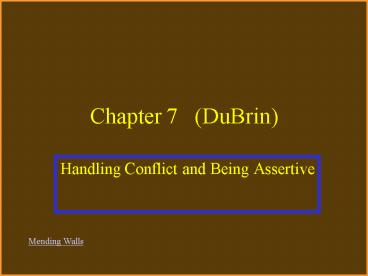Chapter 7 DuBrin - PowerPoint PPT Presentation
1 / 28
Title:
Chapter 7 DuBrin
Description:
Practical. Millennials (1981 to present) Generation X ... What about polarizing ideas? Abortion. Marriage. Right to die. ANWR. Biblical Inerrancy/ Literalism ... – PowerPoint PPT presentation
Number of Views:563
Avg rating:3.0/5.0
Title: Chapter 7 DuBrin
1
Chapter 7 (DuBrin)
- Handling Conflict and Being Assertive
Mending Walls
2
Objectives
- Identify reasons that conflict between people
takes place so often
- Pinpoint several helpful and harmful consequences
of conflict
- Choose an effective method of resolving conflict
- Improve your negotiating skills
- Improve your assertion skills
3
Conflict
- Two sets of demands, goals, or motives are
incompatible. - Often lead to hostility or antagonism.
- Also can be considered a dispute, feud, or
controversy.
4
Detrimental Results of Conflict
- physical and mental health problems
- wasted resources
- the promotion of self-interest
- workplace violence
5
Beneficial Results of Conflict
- emergence of talents and abilities
- constructive innovation and change
- increased unity after the conflict is settled
- Avoids quick and unhelpful agreement
6
Why so much conflict?
- Competition for limited resources
- Personality differences
- Diverse teams/ workforce
- Stone walls and the need to be right
- Sexual harassment
- Ethnic/ Racial harassment
- Competing Work and Family demands
7
Competition for limited resources
Reasons for Conflict
- Money
- Material
- Supplies
- Human help
- The Need to win or be right
8
Personality differences
Reasons for Conflict
- Generational
- Personal Attributes
- Preferences
- Interests
- Values
- Styles
9
Generational Differences
10
Diverse teams/ workforce
Reasons for Conflict
- Ethnicity
- Religion
- Gender
- Differing educational backgrounds
- Inability to communicate because of all the above.
11
Stone walls and the need to be right
Reasons for Conflict
- The pinch.
- Frequent arguments
- Communication breakdown.
12
Sexual harassment
Reasons for Conflict
- Unwanted sexual behavior resulting in discomfort
- A way of gaining power
- A form of aggression/ intentional harm
- A way of achieving an important personal goal
- Two types quid pro quo, hostility (most common)
- Negative effect on productivity
13
Hostile Environment Behavior
Reasons for Conflict
- Inappropriate remarks and sexual implications
- Terms of endearment
- Suggestive complements
- Physical touching
- Unwelcome visual harassment
- Work related kissing
14
Ethnic/ Racial harassment
Reasons for Conflict
- Excluding on the basis of ethnicity
- Ethnic slurs/ comments/ jokes
- Causes lower levels of well-being.
15
Competing Work and Family Demands
Reasons for Conflict
- Caused by multiple and incompatible roles as
worker, spouse, partner, parent. - Frequent cause of conflict
16
Resolving Work/ Family Conflict
Reasons for Conflict
- Flexible work schedules
- Family leave programs
- Dependent-care programs
- Compassionate attitude
- Recognition that work and personal life can be
complementary. Takes individual cases into
consideration.
17
Conflict Resolution Techniques
- Confrontation
- Disarm the opposition
- Cognitive restructuring
- Appeal to a third party
- The grievance procedure
- Engage in metacommunications
- Use negotiation and bargaining tactics
18
Confrontation
Conflict Resolution
- Most recommended
- Gentle and tactful (reasonableness)
- Focuses on the problem at hand, not personalities
- Compromise
- Win-Win - both sides gain something of value
19
Disarm the opposition
Conflict Resolution
- When quick agreement pays off better than a
counterattack. - Your overall position and power are preserved.
20
Cognitive restructuring
- mentally converting negative aspects into
positive ones by looking for the positive
elements in a situation. - Reduces the disputed agenda.
21
Appeal to a third party (such as a government
agency).
- Boss
- Union Steward
- HR manager
- Take opponent to court
22
Engage in metacommunications
- Communicating about communicating
- Talking about differences in communication as
they relate to the conflict can soften the
conflict. - Lunch date
Level and tone of voice. Body language. Choice
of words. (Consider the difference between
disabled and crippled.) Speaking objectively
instead of generalizing.
23
Negotiation and Bargaining
- Positive Climate for Negotiation
- Allowing Room for Reasonable Compromise
- Your best interests come before the position you
defend. - The final offer/ counter-offer
- Negotiation is not about you. When you win your
opponent should think he/ she won. - Valuable relationships must be preserved.
24
More about negotiation on the Internet
- More negotiation tactics (Win-Win)
- More negotiation tactics (Win-Lose)
25
Assertiveness
- Assertive people say clearly what they want and
how they feel without being abusive, abrasive, or
obnoxious.
26
Becoming more assertive
- Set a goal.
- Appear warm and friendly
- Make legitimate telephone calls to strangers.
- To become adept at talking with strangers
- Conduct anonymous conversations.
- Greet strangers
- Practice being decisive (make up your mind for
yourself)
27
What about polarizing ideas?
- Abortion
- Marriage
- Right to die
- ANWR
- Biblical Inerrancy/ Literalism
Alternative Conflict Managementhttp//ohioline.os
u.edu/hyg-fact/5000/5277.html http//www.forgivene
ss-institute.org/
28
Conflict Management Links for further information.
- http//www.ctic.purdue.edu/KYW/Brochures/ManageCon
flict.html - http//www.cnr.berkeley.edu/ucce50/ag-labor/7labor
/13.htm - http//www.mapnp.org/library/grp_skll/grp_cnfl/grp
_cnfl.htm































